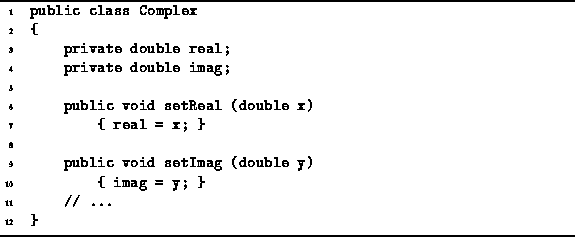A class groups a set of values and a set of operations. The values and the operations of a class are called its members. Fields implement the values and methods implement the operations.
Suppose we wish to define a class to represent
complex numbers .
The Complex class definition shown in Program ![]() illustrates how this can be done.
Two fields, real and imag, are declared.
These represent the real and imaginary parts
of a complex number (respectively).
Program
illustrates how this can be done.
Two fields, real and imag, are declared.
These represent the real and imaginary parts
of a complex number (respectively).
Program ![]() also defines two methods,
setReal and setImag,
which can be used to assign values to the real and imaginary parts
of a complex number (respectively).
also defines two methods,
setReal and setImag,
which can be used to assign values to the real and imaginary parts
of a complex number (respectively).

Program: Complex class fields and methods.
Every object instance of the Complex class contains its own fields. Consider the following variable declarations:
Complex c = new Complex (); Complex d = new Complex ();Both c and d refer to distinct instances of the Complex class. Therefore, each of them has its own real and imag field. The fields of an object are accessed using the dot operator. For example, c.real refers to the real field of c and d.imag refers to the imag field of d.
Program ![]() also defines the methods setReal and setImag.
In general,
a method performs some operation on an instance of the class.
Again, the dot operator is used to specify the object on which
the operation is performed.
For example, c.SetReal(1.0) invokes the setReal method on c
and d.toString() invokes the toString method on d.
also defines the methods setReal and setImag.
In general,
a method performs some operation on an instance of the class.
Again, the dot operator is used to specify the object on which
the operation is performed.
For example, c.SetReal(1.0) invokes the setReal method on c
and d.toString() invokes the toString method on d.